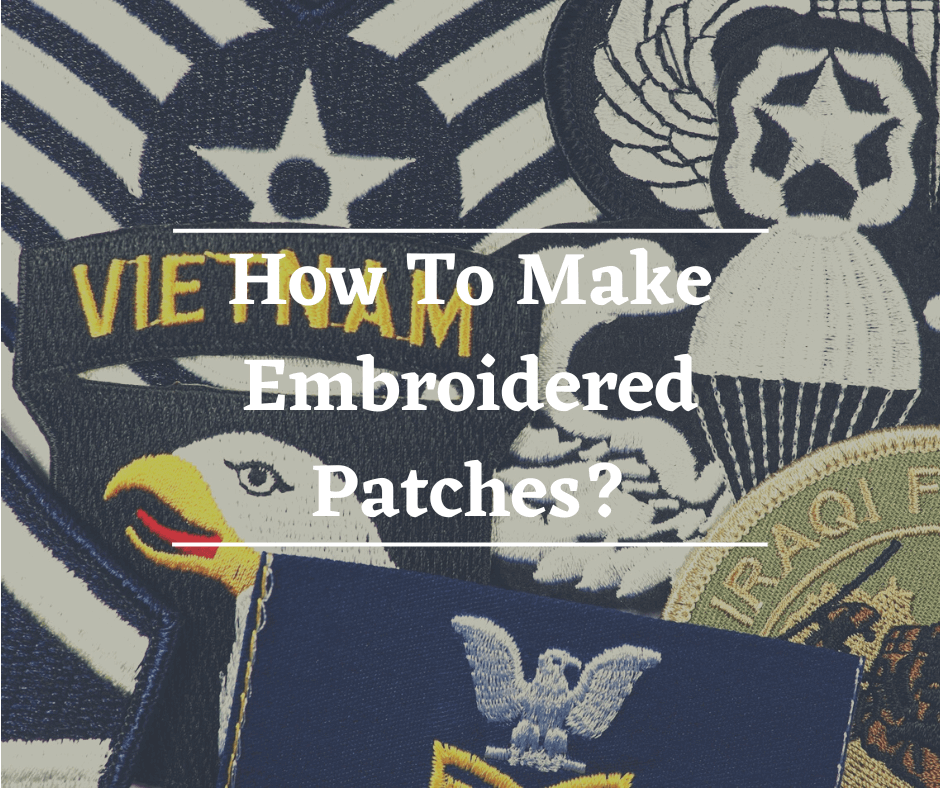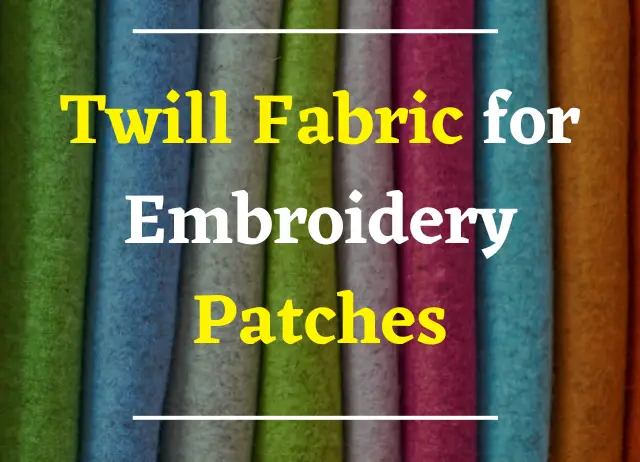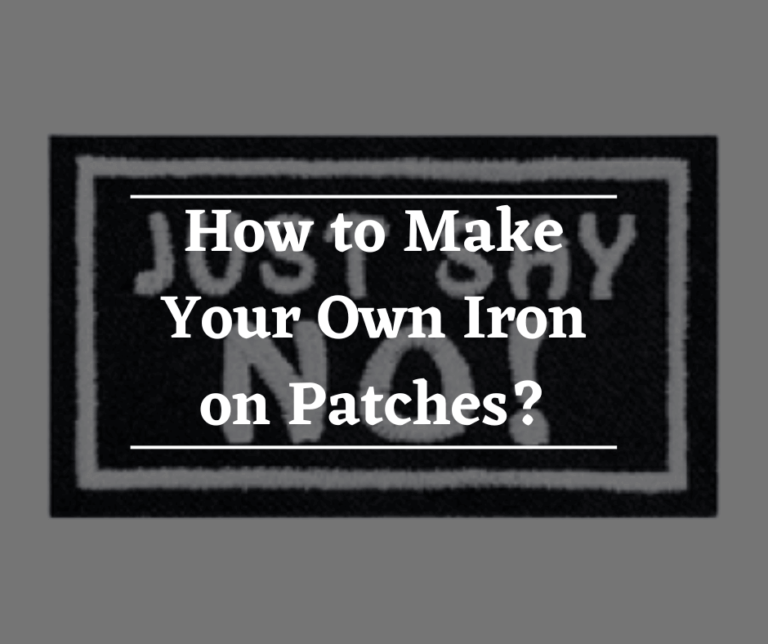How To Make Embroidered Patches?

Embroidered patches are a simple way to add personality and uniqueness to any fabric item – from t-shirts to jackets, hats, bags, and more. So if you’ve ever seen someone wearing an eye-catching embroidered patch or wondered what they’re all about, this blog is for you!
It’s filled with everything you need to know about popular embellishments, including their history and how they can be used in modern times. So get ready to discover how to make embroidered patches – it’s easier!
Contents
- Gathering Materials
- How To Make Embroidered Patches
- Tips For Creating A Successful Design
- Transferring The Design Onto The Fabric
- Tips For Ensuring Accurate Transfer Of The Design On The Fabric
- Embroidering The Patch
- Tips For Achieving A Professional-Looking Patch
- Finishing The Patch
- Tips For Storing And Caring For The Finished Patch
- 1. Keep It Flat
- 2. Avoid Excessive Heat And Moisture
- 3. Clean It Gently
- 4. Keep Away From Sharp Objects
- Frequently Asked Questions
- Which fabric should I use for embroidering patches?
- What are embroidered patches, and what are they used for?
- What materials do I need to make an embroidered patch?
- What embroidery stitches should I use for making an embroidered patch?
- Can I make an embroidered patch without a sewing machine?
- How do you make custom embroidery patches?
- Are there any special techniques for making a 3D embroidered patch?
- Conclusion
Gathering Materials
The tools and materials you need to create your own embroidered patches are straightforward. You will need the following:
- A piece of fabric (most people use felt fabric or twill fabric, but other fabrics like cotton can work too)
- A thread that matches or complements the fabric
- Embroidery thread (optional for more intricate details)
- A needle
- Embroidery hoop
- Embroidery scissors
- Iron on backing
You can purchase these materials online or in craft stores since they are easy to find.
How To Make Embroidered Patches
There are different methods for this. For example:
1. Freehand Drawing
You can draw your design directly onto the fabric with a fabric marker or other drawing tool. The advantage of this method is that it allows you to be creative, but it’s also the most time-consuming.
2. Using A Stencil Or Pattern
This is a great way to save time, as you can trace a template onto the fabric quickly. In addition, plenty of patterns and stencils are available online to use for inspiration or create your own.
3. Printing A Design Onto Transfer Paper
This method allows you to print directly onto transfer paper, which can then be ironed onto your fabric. This is the quickest and most efficient way to create and embroider a patch, but it requires a printer.
3. Embroidery Software
If you want to create a more complex design, you can use embroidery software. This method is perfect for those who are familiar with computers and have some experience with a digital one. Consider experimenting with different styles, such as Flat Embroidery Patches, which offer a sleek and modern look.
Tips For Creating A Successful Design
1. Use Simple And Bold Lines
You want to ensure that your piece is easy to read and recognize, so use bold lines and simple shapes. People should quickly recognize what the patch is meant to represent.
2. Keep It Symmetrical
When you are creating your design, make sure that it is symmetrical. This will help to ensure that the finished patch looks balanced and professional.
3. Choose colors wisely:
The colors you choose for your will make a big difference. Choose colors that will stand out and complement each other, but avoid using too many colors, as this can cause the patch to look busy and overwhelming.
4. Avoid Small Details
When it comes to embroidery, less is often more. Keep it simple with fewer details, as too many small details, can be difficult to stitch and may not look as good when finished.
Transferring The Design Onto The Fabric
You can transfer the thought onto the fabric using these methods:
1. Tracing:
This method involves tracing onto the fabric with a pencil or other transfer tool. The advantage of this method is that it’s quick and easy, but it can be a bit difficult to achieve a precise outline.
2. Ironing On Transfer Paper
This is the quickest and most efficient way to transfer a design onto fabric. Simply print it onto transfer paper, cut it out, place it, and iron it on a medium heat setting. Be sure to use a damp cloth between the paper and the fabric to protect it from burning.
Tips For Ensuring Accurate Transfer Of The Design On The Fabric
1. Use A Lightbox Or Well-Lit Area
When transferring, it’s essential to have a well-lit area or lightbox to see what you are doing accurately.
2. Trace The Design Multiple Times
It’s a good idea to trace the design several times on different areas of the material to ensure that it is accurately transferred.
3. Use Tailor’s Chalk
Tailor’s chalk is a great way to transfer, as it can be easily removed after stitching. Simply draw your design with a tailor’s chalk, then gently rub the chalk away after stitching.
Embroidering The Patch
Different embroidery stitches can be used to transfer your innovation. This can be done by:
1. Backstitch
This is the most basic and common stitch used for embroidery, as it creates a smooth line and is easy to learn. The backstitch is perfect for outlining the shape and adding details.
To do this, start by threading the needle with a thread length twice the size of your desired stitch. A knot can be used to secure the thread at one end. Next, pinch the needle at the other end and push it through the fabric, pulling it tight.
2. Satin Stitch
This stitch is used to fill in the shape adding color and texture. To do this, use a single strand of thread, and push the needle from the top of the piece to the bottom. Keep tension on the thread as you stitch, and do not pull the threads too tight.
3. Stem Stitch
A stem stitch is a decorative stitch that outlines shapes and adds texture. The stitch is created by bringing the needle up from the back of the material and pushing it down again at a slight angle before continuing along the line. This stitch is perfect for outlining the shape of your design and adding details.
Tips For Achieving A Professional-Looking Patch
1. Use The Right Thread Tension
Making sure your thread is tight enough while you’re stitching will help ensure that your patch looks professional. This is important because the loose thread can cause it to fray or pull apart. The more even the tension, the better your results will be. For example, you can use the backstitch for outlining and the satin stitch, a technique perfect for creating smooth, finished satin edges, for filling in shapes.
2. Keep The Stitches Evenly Spaced
Embroidery looks best when the stitches are evenly spaced and of equal length. Pacing your stitches will help create a uniform look and prevent it from bunching up. The backstitch and satin stitch are both excellent options for this, as they’re relatively easy to keep even.
3. Use Suitable Materials
Using suitable materials is key to achieving a professional-looking piece. Make sure you use fabric ideal for embroidery and the right type of thread for your design. Additionally, you’ll want to use an embroidery hoop and loop or frame to keep it taut as you stitch. This will help ensure that your stitches stay even and neat.
4. Take Your Time
When it comes to embroidery, patience is key. Don’t rush the process, as this can lead to sloppy stitches and unevenness. Instead, take the time to plan out your design and practice your stitches before you start stitching. Then, with a bit of patience, you’ll be sure to make custom professional-looking embroidery patches.
Finishing The Patch
1. Cutting Out The Embroidered Patch Leaving A Small Border Around The Design
Once you have designed and embroidered it, it’s time to finish it by cutting it out of it. To do this, you’ll want to use embroidery scissors and cut out the piece leaving a small border around the design.
Start by cutting along the outside of your design and then trim away the excess piece. This will help give your patch a cleaner, more professional look. However, be careful not to cut too close, or you may lose some of your embroidery work.
2. Adding The Iron-On Backing
The last step is to add the iron-on backing. This will help secure your design and enable you to attach the patch to any item. You can purchase iron-on backing online or in craft stores.
The iron-on backing can be ironed in just a few steps. First, make sure that the material side of your patch is facing up and place it onto the ironing board. Then, place the iron-on backing on top and press it with a hot iron for 10-15 seconds. Finally, allow it to cool; your effort is complete!
Tips For Storing And Caring For The Finished Patch
1. Keep It Flat
To ensure it remains in good condition, it’s essential to store it flat. This will help prevent any warping or curling of the material. The best way to store your patch is in a folder or envelope.
2. Avoid Excessive Heat And Moisture
Since it is made from fabric, it’s essential to avoid exposing it to excessive heat or moisture because this can cause it to fade or become damaged. So, don’t leave it in the sun or near any other heat source for too long.
3. Clean It Gently
To clean the patch, use a damp cloth and wipe away any dirt or debris. Try not to scrub too hard, as this could cause the fabric to tear or fray. It is recommended that you dry it after cleaning to prevent fading.
4. Keep Away From Sharp Objects
If any sharp objects are near your patch, keep them away, as they can cause snags or rips in the fabric.
This is all about how to make patches with no hassle, you can also learn How to Make Your Own Iron on Patches.
Frequently Asked Questions
Which fabric should I use for embroidering patches?
You can use many different types of fabric for embroidering. Common fabrics include felt & twill, cotton, and polyester. Your choice of fabric should depend on the design you are creating, and the durability required. However, it is essential to note that some fabrics may require special stabilizers or interfacing in order to ensure your design will not distort when stitched.
What are embroidered patches, and what are they used for?
Embroidered patches are decorative fabrics that can be applied to clothing or other textiles. They are often used on uniforms, jackets, hats, bags, and other items for decoration or identification purposes. They are a great way to show off your design skills, commemorate special occasions, and promote businesses or organizations.
What materials do I need to make an embroidered patch?
The materials you need will depend on the type of design you are creating. Generally, you will need fabric, a stabilizer or interfacing, embroidery thread, and an embroidery machine. Depending on your design’s complexity, you may also require additional items such as needles, scissors, and a transfer pen or lightbox.
What embroidery stitches should I use for making an embroidered patch?
The type of embroidery stitch you use will vary depending on the design. Some commonly used embroidery stitches are satin stitch, stem stitch and backstitch.
Can I make an embroidered patch without a sewing machine?
Yes, it is possible without a sewing machine. You can use hand embroidery to stitch the design onto the fabric, although this can be time-consuming and difficult to achieve a professional-looking finish. It is much easier and quicker to use an embroidery machine.
How do you make custom embroidery patches?
Making custom embroidery patches requires a few steps. First, you will need to gather the tools and materials you need. Then you have to create a design, transfer it onto the fabric, and finally stitch it using an embroidery machine or by hand.
Are there any special techniques for making a 3D embroidered patch?
Yes. To achieve the desired effect of your design, you will need to use special techniques such as cording, puff embroidery, raised fill stitches, and applique. These techniques allow you to create a 3D effect.
Conclusion
You might often wonder how to easily make your own embroidered patches. Creating an embroidered one is a fun and rewarding experience. With the right tools, designs, and materials, you can create a beautiful piece that will last for years.
Whether you’re using simple hand-embroidery techniques or more complex digital designs, the process of gathering the material, creating the design, and finishing it can be a great way to show your creativity and display your patches. Although it seems like a lot of work, the result will be worth it! So, give it a try and enjoy the process.






